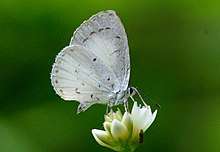Udara akasa
Udara akasa, the white hedge blue,[1][2] is a small butterfly found in India[3] that belongs to the lycaenids or blues family.
| White hedge blue | |
|---|---|
.jpg) | |
| Scientific classification | |
| Kingdom: | |
| Phylum: | |
| Class: | |
| Order: | |
| Family: | |
| Genus: | |
| Species: | U. akasa |
| Binomial name | |
| Udara akasa (Horsfield, 1828) | |
| Synonyms | |
|
Akasinula akasa | |
Description
Male upperside, forewing: black; a medial triangular area that extends from base outwards to the disc white, suffused at base and anteriorly with iridescent blue that spreads upwards on to the black of the costa; along the dorsum the black ground colour is much paler, in most specimens diffuse fuscous. Hindwing: white, basal third and costal margin broadly suffused with fuscous, the fuscous at base posteriorly overlaid with iridescent blue; a subterminal series of fuscous-black dots and a distinct but very slender black anteciliary line. Underside: white very slightly tinged with bluish; markings all fuscous black, minute and very slender. Forewing: a short discocellular line followed by on anteriorly, strongly curved, discal series of very short detached lines and a more or less obsolescent transverse series of subterminal dots. Hindwing: three subbasal dots in transverse order; a short line on the discocellulars; a spot below the middle of the costa with a smaller spot below it; a posterior discal irregular sinuous series of five or six minute spots and a perfectly regular subterminal series of similar spots. Cilia of both forewings and hindwings white. Antennae, head, thorax and abdomen blackish, the antennae ringed with white; beneath: the palpi, thorax and abdomen snow-white.[4]
Female: Very similar. Upperside: the white area much more extended on both forewings and hindwings. On the former it spreads well into the cell, the latter three-fourths of the wing are white; the dusky basal and costal areas much more restricted than in the male. The iridescent blue suffusion is in many specimens entirely absent, in a few very faintly indicated; the subterminal series of black dots so distinct in the male are generally faint and obsolescent. Underside: as in the male but the markings less distinct. Antennae, head, thorax and abdomen as in the male.[4][5]

Range
It is found in Sri Lanka, south India[1] and Malaya.[6][3]
References
- Varshney, R.K.; Smetacek, Peter (2015). A Synoptic Catalogue of the Butterflies of India. New Delhi: Butterfly Research Centre, Bhimtal & Indinov Publishing. p. 142. doi:10.13140/RG.2.1.3966.2164. ISBN 978-81-929826-4-9.
- Beccaloni, G.; Scoble, M.; Kitching, I.; Simonsen, T.; Robinson, G.; Pitkin, B.; Hine, A.; Lyal, C., eds. (2003). "Udara akasa". The Global Lepidoptera Names Index. Natural History Museum. Retrieved April 23, 2018.
- Evans, W.H. (1932). The Identification of Indian Butterflies (2nd ed.). Mumbai, India: Bombay Natural History Society. pp. 221–226, ser no H21.14.
-

-

- Savela, Markku. "Udara akasa (Horsfield, [1828])". Lepidoptera and Some Other Life Forms. Retrieved July 3, 2018.
- Beccaloni, George; Scoble, Malcolm; Kitching, Ian; Simonsen, Thomas; Robinson, Gaden; Pitkin, Brian; Hine, Adrian; Lyal, Chris. "The Global Lepidoptera Names Index (LepIndex)". Natural History Museum, London. Retrieved 2016-10-15.
- Evans, W.H. (1932). The Identification of Indian Butterflies (2nd ed.). Mumbai, India: Bombay Natural History Society.